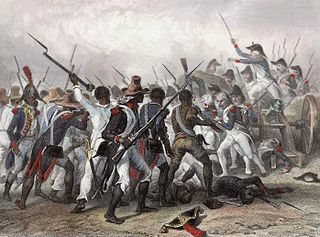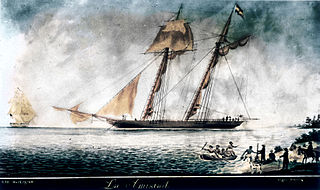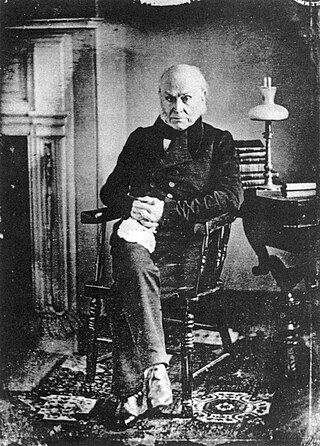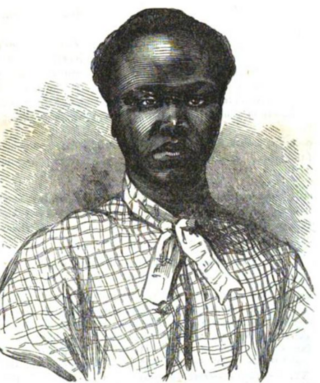Related Research Articles

United States v. Schooner Amistad, 40 U.S. 518 (1841), was a United States Supreme Court case resulting from the rebellion of Africans on board the Spanish schooner La Amistad in 1839. It was an unusual freedom suit that involved international diplomacy as well as United States law. The historian Samuel Eliot Morison described it in 1969 as the most important court case involving slavery before being eclipsed by that of Dred Scott v. Sandford in 1857.

Amistad is a 1997 American historical drama film directed by Steven Spielberg, based on the events in 1839 aboard the Spanish slave ship La Amistad, during which Mende tribesmen abducted for the slave trade managed to gain control of their captors' ship off the coast of Cuba, and the international legal battle that followed their capture by the Washington, a U.S. revenue cutter. The case was ultimately resolved by the U.S. Supreme Court in 1841.

The Mende are one of the two largest ethnic groups in Sierra Leone; their neighbours, the Temne people, constitute the largest ethnic group at 35.5% of the total population, which is slightly larger than the Mende at 31.2%. The Mende are predominantly found in the Southern Province and the Eastern Province. The Mende are mostly farmers and hunters. Some of the major cities with significant Mende populations include Bo, Kenema, Kailahun, and Moyamba.

Mende is a major language of Sierra Leone, with some speakers in neighboring Liberia and Guinea. It is spoken by the Mende people and by other ethnic groups as a regional lingua franca in southern Sierra Leone.

Sengbe Pieh, also known as Joseph Cinqué or Cinquez and sometimes referred to mononymously as Cinqué, was a West African man of the Mende people who led a revolt of many Africans on the Spanish slave ship La Amistad in July 1839. After the ship was taken into custody by the US Revenue-Marine, Cinqué and his fellow Africans were eventually tried for mutiny and killing officers on the ship, in a case known as United States v. The Amistad. This reached the U.S. Supreme Court, where Cinqué and his fellow Africans were found to have rightfully defended themselves from being enslaved through the illegal Atlantic slave trade and were released. The US government did not provide any aid to the acquitted Mende People. The United Missionary Society, a black group founded by James W.C. Pennington, helped raise money for the return of thirty-five of the survivors to Sierra Leone in 1842.

Adams National Historical Park, formerly Adams National Historic Site, in Quincy, Massachusetts, preserves the home of United States presidents John Adams and John Quincy Adams, of U.S. envoy to Great Britain, Charles Francis Adams, and of writers and historians Henry Adams and Brooks Adams.

Peacefield, also called Peace field or Old House, is a historic home formerly owned by the Adams family of Quincy, Massachusetts. It was the home of United States Founding Father and U.S. president John Adams and First Lady Abigail Adams, and of U.S. president John Quincy Adams and his First Lady, Louisa Adams. It is now part of the Adams National Historical Park.
Tecora was a Portuguese slave ship of the early 19th century. The brig was built especially for the slave trade although the transport across the Atlantic of human beings as slaves had already been outlawed by several nations in international treaties in the first decade of the 19th century. She was fast and maneuverable in order to evade British patrols that attempted to stop such illegal slave ships off the coast of Africa.

La Amistad was a 19th-century two-masted schooner owned by a Spaniard living in Cuba. It became renowned in July 1839 for a slave revolt by Mende captives who had been captured and sold to European slave traders and illegally transported by a Portuguese ship from West Africa to Cuba, in violation of European treaties against the Atlantic slave trade. Spanish plantation owners Don José Ruiz and Don Pedro Montes bought 53 captives in Havana, Cuba, including four children, and were transporting them on the ship to their plantations near Puerto Príncipe. The revolt began after the schooner's cook jokingly told the slaves that they were to be "killed, salted, and cooked." Sengbe Pieh unshackled himself and the others on the third day and started the revolt. They took control of the ship, killing the captain and the cook. Three Africans were also killed in the melee.

James Benjamin Covey was a sailor, remembered today chiefly for his role as interpreter during the legal proceedings in the United States federal courts that followed the 1839 revolt aboard the Spanish slave ship La Amistad. Covey, who spoke Mende and English, was instrumental for enabling the Mende passengers of the Amistad to communicate with the court and to defend themselves successfully against charges of mutiny and murder.

Lewis Tappan was a New York abolitionist who dedicated his efforts to securing freedom for the enslaved Africans aboard the Amistad. He was born in Northampton, Massachusetts, into a Calvinist household.

Barnabas Root, born Fahma Yahny, was the grandson of an American-born slave who had moved to Africa through the efforts of the American Colonization Society. Yahny attended the original Mendi Mission school in Mendiland, Sierra Leone, where he was educated by Mary McIntosh, an alumna of Knox College, in Galesburg, Illinois, which was founded in the Calvinist tradition. The College and many of the Congregational churches of the city were active with the American Missionary Association.

David George was an African-American Baptist preacher and a Black Loyalist from the American South who escaped to British lines in Savannah, Georgia; later he accepted transport to Nova Scotia and land there. He eventually resettled in Freetown, Sierra Leone where he would eventually die. With other enslaved people, George founded the Silver Bluff Baptist Church in South Carolina in 1775, the first black congregation in the present-day United States. He was later affiliated with the First African Baptist Church of Savannah, Georgia. After migration, he founded Baptist congregations in Nova Scotia and Freetown, Sierra Leone. George wrote an account of his life, an important early slave narratives.

Mutiny on the Amistad: The Saga of a Slave Revolt and Its Impact on American Abolition, Law, and Diplomacy (1987) is a history of a notable slave mutiny of 1839 and its aftermath, written by professor Howard Jones.
Sierra Leonean Americans are an ethnic group of Americans of full or partial Sierra Leonean ancestry. This includes Sierra Leone Creoles whose ancestors were African American Black Loyalists freed after fighting on the side of the British during the American Revolutionary War. Some African Americans trace their roots to indigenous enslaved Sierra Leoneans exported to the United States between the 18th and early 19th century. In particular, the Gullah people of partial Sierra Leonean ancestry, fled their owners and settled in parts of South Carolina, Georgia, and the Sea Islands, where they still retain their cultural heritage. The first wave of Sierra Leoneans to the United States, after the slavery period, was after the Sierra Leone Civil War in the 1990s and early 2000s. According to the American Community Survey, there are 34,161 Sierra Leonean immigrants living in the United States.

Like most contemporaries, John Quincy Adams's views on slavery evolved over time. He never joined the movement called "abolitionist" by historians—the one led by William Lloyd Garrison—because it demanded the immediate abolition of slavery and insisted it was a sin to enslave people. Further, abolitionism meant disunion and Adams was a staunch champion of American nationalism and union.
Mendi is the capital of the Southern Highlands Province of Papua New Guinea.

The Amistad Memorial in New Haven, Connecticut, is a bronze sculpture created by Ed Hamilton to recognize the events of the 1839 Amistad Affair. The affair was a kidnapping of 53 Africans and their subsequent mutiny aboard La Amistad. It led to a historically significant United States Supreme Court case, in which the Amistad captives were ruled to be acting in self-defense, thereby granting them the right to mutiny.

Ellis Gray Loring was an American attorney, abolitionist, and philanthropist from Boston. He co-founded the New England Anti-Slavery Society, provided legal advice to abolitionists, harbored fugitive slaves in his home, and helped finance the abolitionist newspaper, the Liberator. Loring also mentored Robert Morris, who went on to become one of the first African-American attorneys in the United States.

Sarah Margru Kinson was a West African educator. As Margru or Mar'gru, she was one of the four children on La Amistad. As Sarah Kinson, she was educated at Oberlin College and returned to West Africa to be a missionary teacher. She is considered the first woman born in Africa to be educated in an American college.
References
- ↑ "Collections". Nps.gov. Retrieved 18 January 2015.
- 1 2 "New York Journal of Commerce, 11/27/1841". Archived from the original on July 3, 2008. Retrieved January 6, 2011.
- ↑ Archived August 19, 2006, at the Wayback Machine
- 1 2 Archived September 30, 2007, at the Wayback Machine
- ↑ Archived September 2, 2006, at the Wayback Machine
- ↑ "Committee Reports". Thomas.loc.gov. Archived from the original on 18 January 2016. Retrieved 18 January 2015.
- ↑ "H-SHEAR". H-net.org. Retrieved 18 January 2015.
- ↑ "NewStandard: 11/17/96". Archived from the original on October 7, 2007. Retrieved January 3, 2007.
- ↑ "£2m security plan after museum raid". Museum-security.org. Retrieved 18 January 2015.
- ↑ "Local News Updates - Patrick to take oath on bible that belonged to freed Amistad slaves -The Boston Globe". Archived from the original on July 17, 2010. Retrieved January 6, 2011.
- ↑ Archived November 2, 2012, at the Wayback Machine

